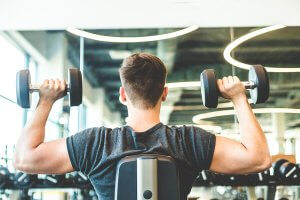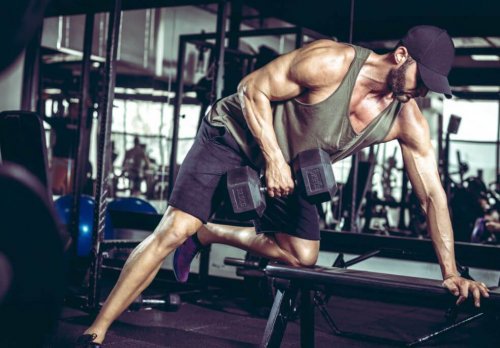10 Tips to get Started with Weightlifting

In many cases, getting started with weightlifting can be a real challenge at first. Doing it provides lots of benefits, but at the same time, improper executions can cause any type of ailment or injury that can stop our progression. To ensure that doesn’t happen, in today’s article, we’ll show you a series of tips for those who want to get started with weightlifting.
What benefits does weightlifting provide?
As we mentioned earlier, weightlifting entails a series of benefits for both our physical state and general health. For example, some of them are:
- It improves our cardiovascular system.
- Strengthens and tones the muscles involved.
- Accelerates our metabolism.
- It helps us burn fat.
- Reduces blood pressure and increases bone density. This is more incipient in women, which helps prevent osteoporosis in many cases.
- Prevents the loss of muscle mass as a result of age.
tips to get started with weightlifting: the importance of correct technique
Without a doubt, weightlifting provides multiple benefits. However, when trying to achieve them, the results we obtain will be counterproductive if we don’t have the appropriate means or guidelines.
The doubts that arise when we get started with weightlifting have much to do with the amount of weight that we’ll be lifting, body posture, or the frequency of the workouts.
To answer all these questions, it’s essential to seek an assessment from a professional in sports sciences, who can advise us and correct our technique. All this will allow us to eliminate risks and begin to lift weights as safely as possible, reducing the chances of suffering an injury.

Tips to get started with weightlifting
Before beginning any program or routine, it’s important to follow these tips to get started with weightlifting:
- Start with a good warm-up. Before we start lifting weights or dumbbells, it’s essential to activate the muscles that we’ll train in the session. This is key to decreasing the risk of injury. It’s convenient to carry out mobility movements in the main joints and the most important body segments.
- Importance of technical execution. Learning the right technique is crucial. In most cases, it’s best to seek the advice of a good professional to achieve this. If that isn’t possible, we can pay attention to the images on many machines. At first, we should practice the technical movement without any weight and increase the load progressively.
Good postural control
- Proper technique is essential, just as having a good motor and postural control is. Again, the right weight choice will be very important here because any movement we don’t properly control can be counterproductive.
- Breath correctly. We must avoid the Valsalva maneuver at all costs as well as holding our breath when weightlifting. We should inhale before performing the movement and exhale during the maximum effort while lifting the weight.
- Pay attention to the choice of weights. It’ll be convenient to never use a weight that forces us to boost ourselves to get up. Good postural control plays an important role here as well.

- Start with dumbbells. When we start weightlifting, it’s advisable to use dumbbells to lift weight instead of bars or machines. This will allow us to gain greater muscular strength at the beginning, which will make it easier to progressively increase the weight load.
- Haste isn’t a good counselor. It’ll be essential to follow proper training progression. First, the most important thing is to acquire a good technique and then, gradually increase the weight. By training regularly, we’ll notice the physical changes that occur.
- Good hydration at all times. As in any other activity, it’ll be essential to stay well hydrated throughout the training. Let’s not forget that 75 percent of our muscles consist of water, so it’s crucial to take care of this aspect, even when we’re not thirsty.
- Start with sets of 15-20 reps. As we mentioned earlier, when we start weightlifting, the intensity shouldn’t be high.
- We will have to start with three days a week of training. It’s necessary to prioritize the resting periods between sessions since our muscles can be considerably sore in the first days.
Conclusions
As we can see, getting started with weightlifting is possible for anyone. However, to avoid an injury or stop this practice prematurely, it’s important to follow the advice outlined above. Don’t wait any longer, get up and become an expert in weightlifting!
In many cases, getting started with weightlifting can be a real challenge at first. Doing it provides lots of benefits, but at the same time, improper executions can cause any type of ailment or injury that can stop our progression. To ensure that doesn’t happen, in today’s article, we’ll show you a series of tips for those who want to get started with weightlifting.
What benefits does weightlifting provide?
As we mentioned earlier, weightlifting entails a series of benefits for both our physical state and general health. For example, some of them are:
- It improves our cardiovascular system.
- Strengthens and tones the muscles involved.
- Accelerates our metabolism.
- It helps us burn fat.
- Reduces blood pressure and increases bone density. This is more incipient in women, which helps prevent osteoporosis in many cases.
- Prevents the loss of muscle mass as a result of age.
tips to get started with weightlifting: the importance of correct technique
Without a doubt, weightlifting provides multiple benefits. However, when trying to achieve them, the results we obtain will be counterproductive if we don’t have the appropriate means or guidelines.
The doubts that arise when we get started with weightlifting have much to do with the amount of weight that we’ll be lifting, body posture, or the frequency of the workouts.
To answer all these questions, it’s essential to seek an assessment from a professional in sports sciences, who can advise us and correct our technique. All this will allow us to eliminate risks and begin to lift weights as safely as possible, reducing the chances of suffering an injury.

Tips to get started with weightlifting
Before beginning any program or routine, it’s important to follow these tips to get started with weightlifting:
- Start with a good warm-up. Before we start lifting weights or dumbbells, it’s essential to activate the muscles that we’ll train in the session. This is key to decreasing the risk of injury. It’s convenient to carry out mobility movements in the main joints and the most important body segments.
- Importance of technical execution. Learning the right technique is crucial. In most cases, it’s best to seek the advice of a good professional to achieve this. If that isn’t possible, we can pay attention to the images on many machines. At first, we should practice the technical movement without any weight and increase the load progressively.
Good postural control
- Proper technique is essential, just as having a good motor and postural control is. Again, the right weight choice will be very important here because any movement we don’t properly control can be counterproductive.
- Breath correctly. We must avoid the Valsalva maneuver at all costs as well as holding our breath when weightlifting. We should inhale before performing the movement and exhale during the maximum effort while lifting the weight.
- Pay attention to the choice of weights. It’ll be convenient to never use a weight that forces us to boost ourselves to get up. Good postural control plays an important role here as well.

- Start with dumbbells. When we start weightlifting, it’s advisable to use dumbbells to lift weight instead of bars or machines. This will allow us to gain greater muscular strength at the beginning, which will make it easier to progressively increase the weight load.
- Haste isn’t a good counselor. It’ll be essential to follow proper training progression. First, the most important thing is to acquire a good technique and then, gradually increase the weight. By training regularly, we’ll notice the physical changes that occur.
- Good hydration at all times. As in any other activity, it’ll be essential to stay well hydrated throughout the training. Let’s not forget that 75 percent of our muscles consist of water, so it’s crucial to take care of this aspect, even when we’re not thirsty.
- Start with sets of 15-20 reps. As we mentioned earlier, when we start weightlifting, the intensity shouldn’t be high.
- We will have to start with three days a week of training. It’s necessary to prioritize the resting periods between sessions since our muscles can be considerably sore in the first days.
Conclusions
As we can see, getting started with weightlifting is possible for anyone. However, to avoid an injury or stop this practice prematurely, it’s important to follow the advice outlined above. Don’t wait any longer, get up and become an expert in weightlifting!
All cited sources were thoroughly reviewed by our team to ensure their quality, reliability, currency, and validity. The bibliography of this article was considered reliable and of academic or scientific accuracy.
- Gunning, J.L., Callaghan, J.P. y MacGull, S.M. (2001). Spinal posture and prior loading history modulate compressive strength and type of failure in the spine: a biomechanical study using a porcine cervical spine model. Clinical Biomechanics, 16, 471-480.
- Morán-Navarro, R.; Martínez-Cava, A.; Sánchez-Medina, L.; Mora-Rodríguez, R.; González-Badillo, J.; J. & Pallarés, J. G. (2019). Movement velocity as a measure of level of effort during resistance exercise.
This text is provided for informational purposes only and does not replace consultation with a professional. If in doubt, consult your specialist.








